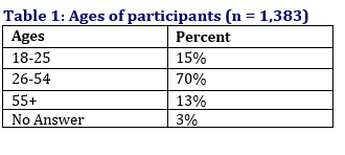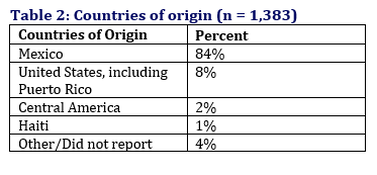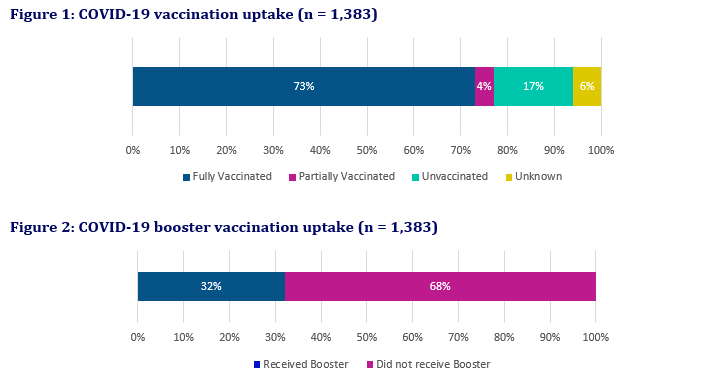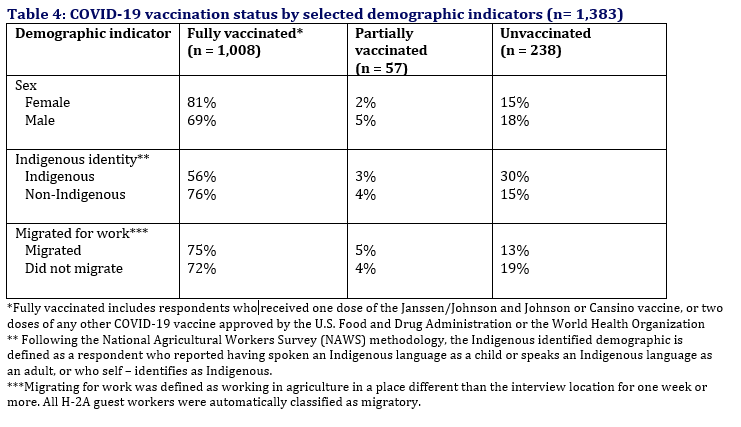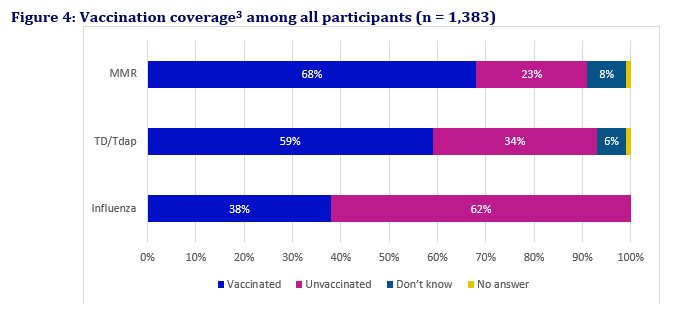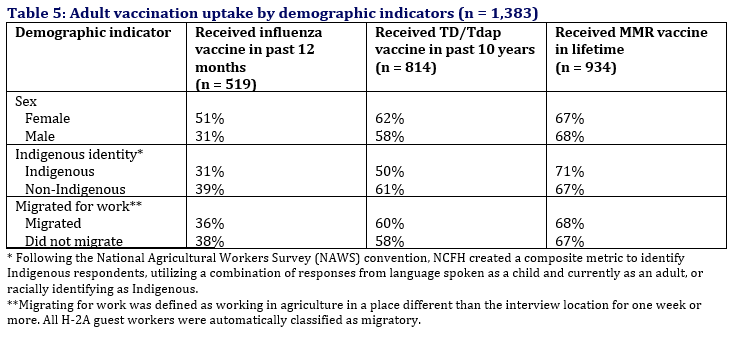Vaccination Coverage Among Farmworkers in Selected U.S. Counties in 2022
Created August 2023
Please see our COVID-19 and H-2A Guest Workers in the Southeastern U.S. fact sheet as well as our Farmworker COVID-19 Community Assessment (FCCA) Reports for more information on COVID-19 vaccination uptake among farmworkers.
Click Here to download the fact sheet as a PDF file.
INTRODUCTION
This fact sheet is based on information collected from 1,383 farmworkers participating in Farmworker COVID-19 Community Assessments (FCCAs). The Phase 2 FCCAs were conducted by the National Center for Farmworker Health in 2022 and resided or worked in selected communities in Colquitt County, Georgia; Sampson County North Carolina; Weld County Colorado; Atlantic & Cumberland counties New Jersey, and Yakima County, Washington. Surveys were administered using an establishment-based recruitment and randomized sampling strategy. The data were weighted to adjust for under- or over-sampling of H-2A guest workers in each community, and for the size of the farm labor force in each community. Readers should not generalize these findings to other farmworker communities. Participants were at least 18 years of age, had worked one day or more during the COVID-19 pandemic on a crop or livestock production farm in the U.S., and could be of any immigration status.
DEMOGRAPHICS
Sixty-six percent of participants were male, and 33% were female. Seventeen percent self-identified as racially or linguistically Indigenous and 83% as non-Indigenous [1]. See Table 1 below for the ages of participants. Most of the farmworkers were between the ages of 26 and 54 (70%). The participants reported several countries of origin, with 84% born in Mexico, 8% born in the United States, including Puerto Rico, and 2% born in countries in Central America (Table 2).
Created August 2023
Please see our COVID-19 and H-2A Guest Workers in the Southeastern U.S. fact sheet as well as our Farmworker COVID-19 Community Assessment (FCCA) Reports for more information on COVID-19 vaccination uptake among farmworkers.
Click Here to download the fact sheet as a PDF file.
INTRODUCTION
This fact sheet is based on information collected from 1,383 farmworkers participating in Farmworker COVID-19 Community Assessments (FCCAs). The Phase 2 FCCAs were conducted by the National Center for Farmworker Health in 2022 and resided or worked in selected communities in Colquitt County, Georgia; Sampson County North Carolina; Weld County Colorado; Atlantic & Cumberland counties New Jersey, and Yakima County, Washington. Surveys were administered using an establishment-based recruitment and randomized sampling strategy. The data were weighted to adjust for under- or over-sampling of H-2A guest workers in each community, and for the size of the farm labor force in each community. Readers should not generalize these findings to other farmworker communities. Participants were at least 18 years of age, had worked one day or more during the COVID-19 pandemic on a crop or livestock production farm in the U.S., and could be of any immigration status.
DEMOGRAPHICS
Sixty-six percent of participants were male, and 33% were female. Seventeen percent self-identified as racially or linguistically Indigenous and 83% as non-Indigenous [1]. See Table 1 below for the ages of participants. Most of the farmworkers were between the ages of 26 and 54 (70%). The participants reported several countries of origin, with 84% born in Mexico, 8% born in the United States, including Puerto Rico, and 2% born in countries in Central America (Table 2).
The top languages currently spoken by this sample of respondents included Spanish, English, Mixtec, Zapotec, Nahuatl and Tsotsil (Table 3).
[1] Following the National Agricultural Workers Survey (NAWS) methodology, the Indigenous identified demographic is defined as a respondent who reported having spoken an Indigenous language as a child or speaks an Indigenous language as an adult, or who self – identifies as Indigenous.
COVID-19 VACCINATIONS
Most of the participants reported being fully vaccinated [2] against COVID-19 (73%), and 32% had received booster vaccinations. See Figures 1 and 2 below.
[2] Fully vaccinated includes respondents who received one dose of the Janssen/Johnson and Johnson or Cansino vaccine or two doses of any other COVID-19 vaccine approved by the U.S. Food and Drug Administration or the World Health Organization.
Among unvaccinated participants (17% of the total sample), 61% reported that they would not get vaccinated in the future. Fifteen percent of participants said they would get vaccinated in the future, 19% said they may get vaccinated in the future, and 4% did not answer or reported they did not know if they would get vaccinated in the future. See Figure 3 below.
In order to support vaccine campaigns and funding for vaccination among farmworkers, information is provided below on COVID-19 vaccination status for specific subgroups of farmworkers (see Table 4). A higher proportion of non-Indigenous participants (76%) were fully vaccinated against COVID-19 compared to Indigenous participants (56%). A lower proportion of male participants (69%) were fully vaccinated compared to female participants (81%). Overall, the demographic groups of males, Indigenous, and non-migratory farmworkers surveyed had the lowest proportions of reporting being fully vaccinated against COVID-19.
VACCINATIONS COVERAGE FOR INFLUENZA, MEASLES/MUMPS/RUBELLA, AND TETANUS/DIPTHERIA/PERTUSSIS AMONG FARMWORKERS
Among all participants, 68% reported having been immunized for measles, mumps, and rubella (MMR) at some point in their lifetime (Figure 4). Just over half (59%) of farmworker participants reported receiving the TD or Tdap vaccination in the past 10 years. Only 38% of participants reported receiving an influenza vaccine in the past 12 months, the lowest uptake among the three vaccinations.
Among all participants, 68% reported having been immunized for measles, mumps, and rubella (MMR) at some point in their lifetime (Figure 4). Just over half (59%) of farmworker participants reported receiving the TD or Tdap vaccination in the past 10 years. Only 38% of participants reported receiving an influenza vaccine in the past 12 months, the lowest uptake among the three vaccinations.
Lower proportions of male, Indigenous, and migratory workers were reported for most adult vaccinations as compared to female, non-Indigenous and non-migratory workers, similar to the findings on COVID-19 vaccine uptake. A slighty higher proportion of male participants and Indigenous participants reported receiving the MMR vaccine compared to female participants and non-Indigenous participants, respectively. See Table 5.
[3] Measles, Mumps, Rubella (MMR) percentages include those reported as vaccinated if they had received the vaccine at least once in their lifetime. TD/Tdap vaccinated status refers to if they reported having the vaccine in the past 10 years. Flu vaccinated refers to if they reported receiving the vaccine in the past 12 months.

